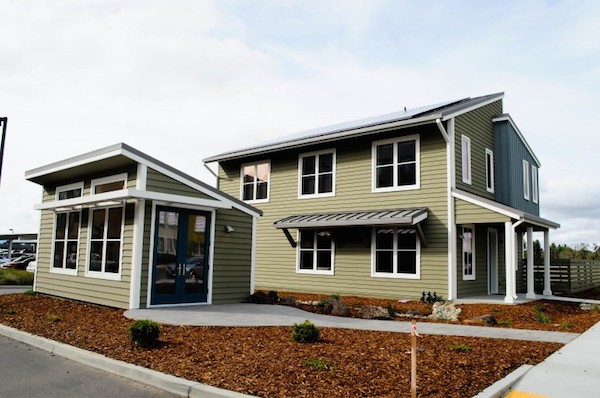
The Honda Smart House US has recently been constructed on campus at the University of California (UC), Davis. The house will serve as a test for an off-the-grid living space of the future. Homes and cars are responsible for about 44% of all the greenhouse gases emitted in the US, and in constructing the house, the designers of The Honda Smart House aimed to try and find a way to neutralize these emissions. The house also generates enough solar energy to power both car and home, with a little left over to feed back into the grid.
The Honda Smart Home US is run by the company’s home energy management system (HEMS). This system is located in the garage and works to monitor and optimize electrical consumption across the home’s micro-grid. Next to the HEMS, the builders installed a 10 kWh battery, which is used for storing energy collected by the 9.5 kW solar photovoltaic system mounted on the roof.


The house was built on a concrete slab, around half of which is actually pozzolan, which occurs naturally in the earth as a result of volcanic ash deposits. Due to the fact that pozzolan doesn’t need to be heated to the same high temperatures as cement when laying the foundation, Honda successfully reduced the carbon emissions from the construction of the house.
The heating and cooling of the house is taken care of via a geothermal heat pump, which also supplies the hot water for the household. Water is heated in a tank from where it is used to take a shower. Then the grey water drained from the shower is used to help preheat the cold city water, which further reduces the power needed to supply the hot water for the household.

After it heats the cold water, the drain water from the shower is pumped into four thermal tanks underneath the backyard. The earth’s heat warms the liquid here, and turns it into what the designers call the Ground Source Fluid. This heated fluid is pumped back to the house to heat it by passing through pipes located in the floor, roof and ceiling. In the summer, cold water can be pumped through the house in the same way to provide cooling.
The house was built with the local climate in mind. The north-facing windows maximize natural light and ventilation, while south-facing windows are designed to optimize heating and cooling. The home also has double-stud walls, a metal roof and an insulated concrete base, which all raise the energy efficiency of the house.

Honda also modified their electric car so that it can be charged directly from the home’s solar panels or the battery, which reduces the loss of energy that happens during a DC to AC conversion. To further reduce energy demands, LED lighting was installed throughout the house, while the lighting is also designed to mimic shifts in natural lighting during the day and night. They worked closely with the California Lighting Technology Center at UC Davis to explore a new form of circadian color control lighting. The house is lit with blue-rich light in the daytime, which are designed to optimize alertness and energy. In the evenings and at night, the lighting is amber toned, which creates a more relaxed atmosphere.
According to the designers, the Honda Smart House US is three times more water-efficient and uses half the energy of similar-sized homes in the area. They further estimate that the house will generate a surplus of 2.6 MWh, which equates to an offset in carbon emissions of nearly 13,100 lb (5,942 kg) per year.

Unfortunately, this house is not yet on the market. Honda and researchers from UC Davis and Pacific Gas and Electric will be using it as a laboratory to carry out ongoing evaluations of new technologies and real-world applications in the housing, transportation and energy sectors.


Related Articles on JetsonGreen.com:
A Family Home That’s as One With Nature
A Zero Net Energy Prototype House Built in California
FluxHome: An Easy To Monitor Smart Home

Leave a Reply
You must be logged in to post a comment.